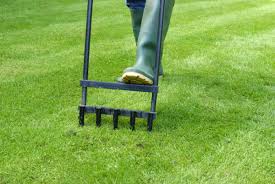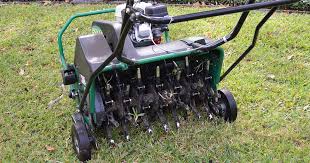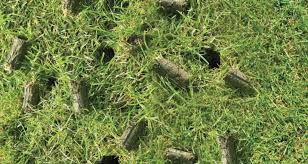Aerating lawn simply means creating small holes in the soil to allow better air, water, and nutrient penetration to the grassroots. Over time, lawns can become compacted due to heavy foot traffic, mowing, and natural settling. This compaction restricts the flow of essential elements to the roots, making it difficult for the grass to grow and thrive.
By aerating your lawn, you can break up this compacted soil, promoting healthier root development and better absorption of nutrients. The process also improves the soil’s overall structure, making it easier for roots to spread and establish a strong foundation.
There are two primary types of lawn aerators: spike aerators and plug aerators. Spike aerators use solid tines to create holes in the soil, while plug aerators remove small plugs of soil entirely. Both methods have their advantages, but plug aerators are generally considered more effective since they relieve compaction more thoroughly.
The best time to aerate your lawn depends on the type of grass you have. For cool-season grasses like Kentucky bluegrass and fescue, aerate in early spring or fall when the grass is actively growing. Warm-season grasses like Bermuda grass and Zoysia should be aerated during late spring or early summer for optimal results.
Before aerating, it’s crucial to prepare your lawn properly. Mow the grass to a shorter height than usual and water the area thoroughly a day or two before aerating. This will facilitate the aerator’s penetration into the soil and ensure more effective results.
When aerating, make sure to overlap each pass slightly to cover the entire lawn area. After the process is complete, leave the soil plugs on the lawn; they will eventually break down and provide additional nutrients to the soil.
Following aeration, it’s an excellent time to fertilize and overseed your lawn. The newly created holes offer an ideal environment for seed germination, leading to thicker and healthier grass coverage.
Regularly aerating your lawn, once every one to three years depending on soil conditions, can significantly contribute to its long-term health and beauty. Alongside proper watering, mowing, and fertilizing, aeration becomes a valuable part of your lawn care routine.
In addition, aerating lawn is a simple yet vital practice for achieving a beautiful and resilient lawn. By allowing air, water, and nutrients to reach the grassroots more effectively, you’ll enjoy a healthier lawn that can better withstand environmental stressors and look stunning throughout the year. So, grab your aerator and invest in the health of your lawn – your efforts will be rewarded with a vibrant, green oasis right outside your doorstep.
Read Also: 11 Healing Powers of Siam Weed (Awolowo Leaves) Updated
Importance of Aerating Your Lawn

The importance of aerating lawn cannot be overstated when it comes to achieving a healthy and vibrant yard. Here are the key reasons why aerating is a crucial practice for lawn care:
1. Enhanced Nutrient Absorption: Aerating creates channels in the soil, allowing nutrients from fertilizers to reach the grassroots more efficiently. This improved nutrient uptake fosters robust growth and ensures your lawn receives the necessary elements to thrive.
2. Improved Soil Aeration: Compacted soil can become dense and devoid of oxygen, hindering root development. Aerating the lawn promotes better air circulation, creating a more oxygen-rich environment for the roots to breathe and grow deeply.
3. Enhanced Water Infiltration: Soil compaction can lead to water runoff, preventing it from reaching the roots effectively. Aerating the lawn allows water to penetrate the soil more easily, reducing wastage and ensuring optimal hydration for your grass.
4. Stronger Root System: By breaking up compacted soil, aerating encourages root expansion and strengthens the grass’s root system. This, in turn, makes the lawn more resistant to drought, disease, and damage caused by foot traffic.
5. Reduced Thatch Buildup: Thatch is a layer of dead grass and debris that accumulates on the soil surface. Aeration helps to break down thatch, preventing it from becoming too thick and impeding the movement of water and nutrients.
6. Enhanced Seed Germination: Aerating creates the perfect environment for seed germination. After aerating, overseeding your lawn can lead to the establishment of new grass, filling in bare spots and improving overall turf density.
7. Better Pesticide and Herbicide Effectiveness: When you aerate your lawn, pesticides and herbicides can penetrate the soil more effectively. This means better control of pests and weeds, leading to a healthier lawn.
8. Environmental Benefits: A well-aerated lawn helps reduce water runoff and soil erosion, promoting a healthier local ecosystem. It also contributes to improved air quality as healthier lawns capture and store carbon dioxide.
In addition, aerating lawn is a vital practice that contributes to the overall health and beauty of your yard. By improving nutrient absorption, soil aeration, water infiltration, and root development, aerating creates a foundation for a lush and resilient lawn. Regularly incorporating this simple yet powerful technique into your lawn care routine can lead to long-lasting benefits and a lawn that becomes the envy of your neighborhood.
Read Also: 29 Healing Powers of Bitterleaf (Vernonia Amygdalina)
Step-by-Step Guide to Aerating Your Lawn

Aerating your lawn is a crucial practice to maintain a healthy and vibrant turf. Here’s a step-by-step guide to help you aerate your lawn effectively:
Step 1: Choose the Right Time
Pick the appropriate time to aerate based on your grass type: early spring or fall for cool-season grasses, and late spring for warm-season grasses.
Ensure the soil is slightly moist but not overly wet. Water the lawn a day or two before aerating if necessary.
Step 2: Prepare the Lawn
Mow the grass to a shorter height than usual. This makes it easier for the aerator to penetrate the soil.
Remove any debris, sticks, or rocks from the lawn to avoid obstructions during the aerating process.
Step 3: Select the Aerator
Decide on the type of aerator you’ll be using: spike aerator or plug aerator.
Plug aerators are generally more effective as they remove small soil plugs, while spike aerators only create holes.
Step 4: Aerating the Lawn
Start aerating your lawn by following a systematic pattern. Consider going in straight lines, back and forth, or in a grid pattern for even coverage.
Overlap each pass slightly to ensure every part of the lawn gets aerated.
Step 5: Pay Attention to High Traffic Areas
Give extra attention to areas of the lawn that experience heavy foot traffic or compaction.
Consider making additional passes over these areas to promote better aeration.
Step 6: Leave the Soil Plugs
After aerating, leave the soil plugs on the lawn. They will break down over time and provide valuable nutrients to the soil.
Step 7: Fertilize and Water
After aerating, apply a suitable fertilizer to the lawn. The newly created holes will allow better nutrient absorption.
Water the lawn thoroughly after fertilizing to help nutrients reach the grassroots.
Step 8: Post-Aeration Care
Avoid heavy use of the lawn for a few days after aerating to allow it to recover.
Continue with regular lawn care practices, including proper watering and mowing.
Step 9: Repeat as Needed
Depending on your lawn’s condition, consider aerating once every one to three years.
Regularly aerating will help maintain a healthy and thriving lawn over the long term.
By following this step-by-step guide, you’ll be able to aerate your lawn properly, ensuring that it receives the necessary air, water, and nutrients to flourish. A well-aerated lawn will have stronger roots and better overall health, making it more resilient to various stressors and maintaining its beauty throughout the seasons
Where to Find Lawn Aeration near Me/You

You can find or locate lawn aerators through various sources. Here are some options:
1. Local Garden Centers or Nurseries: Many garden centers or nurseries offer lawn equipment for rent or purchase, including lawn aerators. Visit a nearby garden center or nursery, and inquire about their rental options or aerator availability.
2. Home Improvement Stores: Large home improvement stores often have equipment rental sections that include lawn aerators. Check with stores like Home Depot, Lowe’s, or similar outlets in your area.
3. Equipment Rental Companies: There are specialized equipment rental companies that focus on lawn and garden equipment. Look for local rental companies that offer lawn aerators for short-term use.
4. Online Equipment Rental Platforms: Several online platforms allow you to rent lawn equipment, including aerators. Websites like Rent-A-Center, The Home Depot Rental, and others offer online rental services for various locations.
5. Landscaping and Lawn Care Services: Some landscaping companies or lawn care services provide aeration as part of their services. If you prefer not to do it yourself, consider hiring a professional to aerate your lawn.
6. Community Tool Rental Programs: Some neighborhoods or community centers offer tool rental programs, where residents can borrow lawn equipment, including aerators, for a specific period.
When looking for lawn aerators, consider factors such as the type of aerator (spike or plug), rental rates, availability, and pick-up/delivery options. Compare prices and reviews to ensure you find a reliable source for your lawn aeration needs.
Read Also: Reasons Why You Should Never Stop Learning
